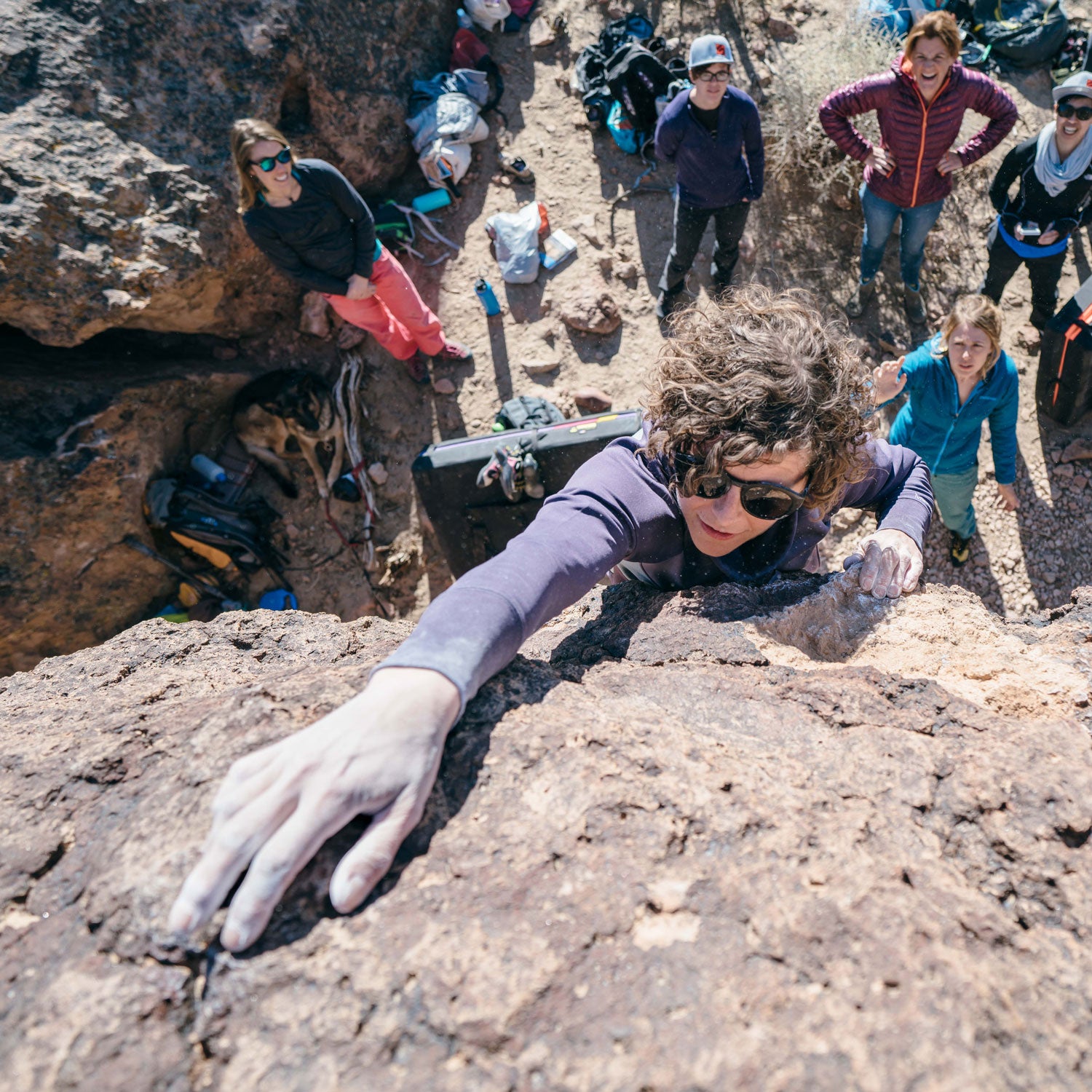At the 2018 �´dz����’s Climbing Fest in Bishop, California, we talked with professional climbers, guides, and industry workers to soak up some advice for beginners. Here’s their best advice for advancing your technique, taking care of your body, and overcoming mental obstacles.
Climb with Your Feet
Many beginner climbers think the sport is all about upper-body strength, says , an outdoor photographer and climber. But paying attention to where you place your feet often allows you to reach higher holds more easily and puts less strain on your arms and fingers. Instead of focusing on pulling on the next hold, she says to “always think with your feet first.”
Don’t Compare Yourself to Others
Negative self-talk can seem insignificant, but it may actually hinder your growth in climbing, says , a professional climber and nutritionist. “Climbing is an individual game, meaning it’s unique for each of us, and that’s the beauty of it. Make it your own thing, celebrate in the differences, and support one another’s triumphs.”
Stretch Your Hips
Flexibility is often overlooked, but it can help you reach different holds, creating more options for solving climbs, according to pro climber and coach Molly Mitchell. Flexibility in your hips opens the door to higher or distant footholds. She suggests this stretch: Lie on the floor in a frog position—as if you’re doing the middle splits, but bend your knees. Stretch for one minute on and one minute off for five total minutes of stretching.
Rely on All Your Fingers
“Always use your pinkies,” professional climber Kyra Condie recommends. “Not only do they make your grip position stronger, but they also help you avoid injuries.”
Take Care of Your Skin
“When your skin is good, climbing doesn’t hurt as much and your day lasts longer,” pro climber Abbey Smith says. She keeps her fingertips clean with a small, durable spray bottle of rubbing alcohol. Smith rests to cool down her body temperature so her hands are dry before attempts, and she files away any rough edges on her hands with fine-grade sandpaper. Post-climbing, Smith repairs her skin with an anti-inflammatory, antibacterial, moisturizing ointment. “Neosporin with pain relief is my favorite,” she says.
Embrace Failure
“Understand that climbing is mostly about being comfortable with failing,” pro climber says, whether that’s a fear of falling, the inability to complete a certain move, or a lack of confidence. Instead of trying to push away feelings of insecurity, Harrington tries to acknowledge them. “I felt so bad about myself every time I was afraid, because none of the boys seemed to be scared. I wanted to be like them,” she says. “I wish I had known that it was perfectly OK to be like me.”
Top-Rope to Learn to Place Gear
To take some of the risk out of gear placement, start on top rope, says , a guide and professional climber. She suggests new climbers weight each piece of gear and bounce-test it. Then, look closely at what the piece does under a little bit of force. “This will not only help you learn how to place gear properly and quickly in a safe environment, but it will also help you learn to trust your gear,” Oakley says. “If pieces pop out—great! You’re learning.”
Focus on Getting Better Instead of Stronger
Professional climber Jenn Flemming says this simple mindset switch helps a lot. “When you’re a beginner, there’s an incredible learning curve in terms of technical knowledge about movement, body position, and strategy,” she says. “Developing competent technique will take you so much further than CrossFit or the hangboard.” How to up your technique: Spend time watching other people climb, observing movement and how different people use their body in different ways. Keep an eye out for how and when climbers rest, and notice their style choices—bent versus straight arms, open hips versus back-stepping. You will get stronger naturally as you climb more. “There’s plenty of time for training when you inevitably plateau a few years in,” Flemming says. “But technical knowledge is crucial and something you can begin developing at the outset.”
Go Ahead and Fall
“I just took my first lead fall outside, and I’m climbing 5.13 in the gym. I refused to take falls, because it felt like failure to me,” says Meaghen Brown, a writer for Patagonia and former ���ϳԹ��� editor. “But falling doesn’t mean that you’re failing. It means that you’re working on something and you’re learning.” As long as you master the proper techniques for lead climbing and you can take safe falls, don’t be afraid to jump right in and lead things at or above your limit, says Sara Nazim, a product developer at Outdoor Research.
Stay Psyched
No matter where you are in the climbing process, attitude is everything, says , a life and nutrition coach. Are you the person who brings eagerness to every climbing session, or are you the person who throws their shoes on the ground when they can’t send a project? Instead of jumping to find an excuse when you can’t finish a route, use your failure as a learning experience. “Enthusiasm and desire to learn are the character traits that really matter while learning to climb, not the grade,” McCandless says.


